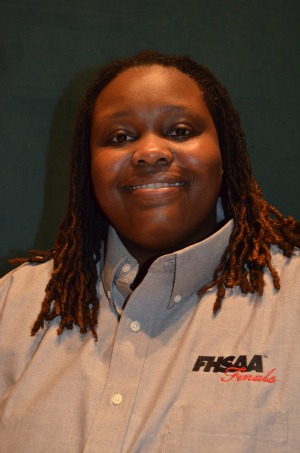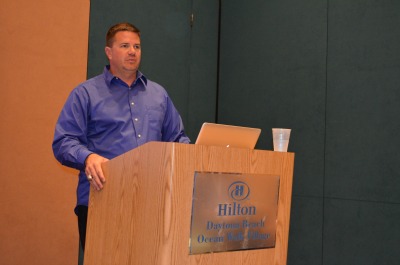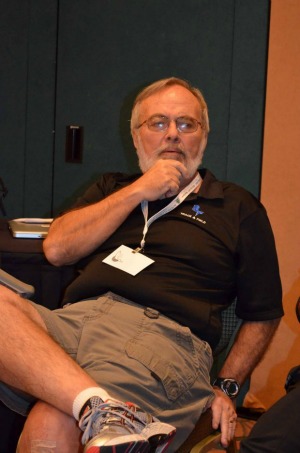

This year’s FACA Conference, held at the luxurious Daytona Hilton Oceanfront Resort, unfortunately overlooked the silver sands of “The World’s Most Famous Beach” and the broad, blue Atlantic beyond. It was “unfortunate” because the scene laid out in panoramic splendor on one side of a room-length window might have posed a conflict of interest to coaches who earn at least part of their living out of doors; succumb to the siren call of the breakers—a mere whisper of its seductive sound escaping through the salted glass—or stay inside and talk track. For those assembled, it proved to be less of a conflict than one might imagine.
Running, ahem, from Thursday to Saturday, the conference offered a look back to the “pillars” of our state’s track community (presenting awards to coaches of the year and hall of fame inductees), a look ahead (rule changes for 2013 and beyond), and a look around (expert clinics on the minutiae of track and field).
From a personal perspective, having first made a brief stop-over at the Daytona International Speedway on Thursday morning—it was ISB’s Fanfest--I was hoping that the subject of the FHSAA Cross Country course might pop up. Having spent a good part of the weekend staring at the wide, flat, hard-packed sand of the beach, I got to thinking: “Why not make the State XC Meet truly unique?” That would certainly be worth investigating.
Clinics
The conference offered 16 clinicians and, between them—by my count--31 clinics. Summarized, they were as follows:
 Bob Braman (FSU) - Peaking for Middle Distance and Distance Runners Ken Brauman (Sanford-Seminole HS) – The Olympic Experience Dr. Christine Brooks (USATF) – Commonalities of the Jumps; The Rotation of the Jump; Long Jump Approach; Adapting to Training Molly Carver (Arnold Palmer Hospital) – Focus on Flexibility Gary England (Tulane) – The Discus; The Shot Put; Strength Training and Lifting Ron Grigg (Jacksonville University) – Hurdle Training; 400 Training, Parts 1 & 2 Bobby Haeck (Pole Vault City) – The Beginning Vaulter; Developing Champions Kristin McWilliams (Winter Park HS) – Training Elite HS Distance Runners Scott Peters (Half Mile Timing) – District and Regional Meets: Host Schools and Meet Managers Jeff Pigg (University of North Florida) – Fundamentals of Middle Distance Running Pete Rea (ZAP Fitness/USA Training Center) – The Arthur Lydiard Distance Model, Parts 1 & 2; Coaching the Individual; Non-Running Exercise; Motivation Ken Taylor and Coach Krupa (University of North Florida) – High Jump Drills and Practice Chuck Wilmot ( Dartfish Video) – Track and Field Software Phil Wollbrinck (McCluer High School, Missouri) –Sprinting; Blocks; Perfecting Relays; The 200 and, of course, the after-mentioned Shanell Young (FHSAA) – Rule Changes for 2013; Officials’ Exam.
Bob Braman (FSU) - Peaking for Middle Distance and Distance Runners Ken Brauman (Sanford-Seminole HS) – The Olympic Experience Dr. Christine Brooks (USATF) – Commonalities of the Jumps; The Rotation of the Jump; Long Jump Approach; Adapting to Training Molly Carver (Arnold Palmer Hospital) – Focus on Flexibility Gary England (Tulane) – The Discus; The Shot Put; Strength Training and Lifting Ron Grigg (Jacksonville University) – Hurdle Training; 400 Training, Parts 1 & 2 Bobby Haeck (Pole Vault City) – The Beginning Vaulter; Developing Champions Kristin McWilliams (Winter Park HS) – Training Elite HS Distance Runners Scott Peters (Half Mile Timing) – District and Regional Meets: Host Schools and Meet Managers Jeff Pigg (University of North Florida) – Fundamentals of Middle Distance Running Pete Rea (ZAP Fitness/USA Training Center) – The Arthur Lydiard Distance Model, Parts 1 & 2; Coaching the Individual; Non-Running Exercise; Motivation Ken Taylor and Coach Krupa (University of North Florida) – High Jump Drills and Practice Chuck Wilmot ( Dartfish Video) – Track and Field Software Phil Wollbrinck (McCluer High School, Missouri) –Sprinting; Blocks; Perfecting Relays; The 200 and, of course, the after-mentioned Shanell Young (FHSAA) – Rule Changes for 2013; Officials’ Exam.
With endless opportunities to learn the nuances of track and field, but only so much time to do so—not to mention the limitations on a human brain to take in new things—choices had to made. As far as which of the clinics to sit in on, a little of this and a little of that worked for me, and probably just as well for the other attendees. The panels added an excellent time to study the different personalities among winning coaches, and to find—once and for all—the common thread that joined the winningest of coaches. My conclusion was there wasn’t one; what worked for one was the opposite of another’s. So it was just a matter of finding, amidst what was being said, that which sounded right for each coach.
Certainly there are discoveries to be made at such a conference, such as the resurgence of LSD (the training technique, of course) and the ratio of aerobic over anaerobic training for distance runners (Pete Rea of Zap). Then there was the überscientific approach to hurdling—and I assume also the 400, although I was too overwhelmed by the former to recover in time for the latter—which was explained slowly, carefully, and thoroughly by Ron Grigg of JU. The biggest guy (Gary England of Tulane) was the most laid back, but that might have been from lack of sleep--he’s a frequent flyer, it seems—but aren’t all weight men? (There’s humor in there somewhere.) And the happiest were the guys with the peer-presented plaques…although Charlie Harris of Lake Brantley led that crowd with his 10 gigawatt smile.
Panels
There were three panel discussions: Elite Distance Coaches Panel -Rene Plascensia (Colonial HS), Doug Butler (Holy Trinity), Jeff Pigg (UNF), Bob Braman (FSU); Pete Rea (Zap); Veteran HS Coaches’ Panel – Sam Burley (Southride HS), James Day (Raines HS), and Bill Wilson (Sebastian River HS); and the State Championship Coaches Panel (Alex Armenteros, Duchane Thomas, Paul Nowicki, Carmen Jackson, Coach Tucker pinch-hitting for Kent Baker, Doug Butler, and Scott Sherrod).
FHSAA Update
 Moderated by Shanell Young, Director of Athletics for FHSAA, the 2013 rule changes, in brief are:
Moderated by Shanell Young, Director of Athletics for FHSAA, the 2013 rule changes, in brief are:
Relay Personnel - 3.14.3.3.1(c) (3)
· Changes between prelims and finals are limited to the contestants/competitors listed on the relay card in the relay event for the duration of the meet once the relay card has been submitted to the clerk of course.
Watches – 4-4-4 (c)
· All jewelry, with the exception of wristwatches, is prohibited. Watches which can be used as Global Positioning Systems (GPS) are prohibited.
Field Event Implements – Rules 3-19-2, 6-2-16
· Only legal implements are allowed in warm-ups and competition
-- The implement inspector shall inspect all throwing implements and only those that are legal shall be permitted in competition as well as warm ups.
-- Competitors are also accountable to use only a legal implement during warm-ups and competition
· The pole vault event has previously restricted the use of an illegal pole in warm-ups and competition
Competitor’s Uniform – Rules 4-3-1, 2 and 9-6-1, 2; Penalties
· Competitor observed in an illegal uniform:
--Observed and noted by official prior to competition-competitor required to make the uniform legal before allowed to compete and without delay of meet
--Competitor shall be issued a warning and subsequent violation of uniform rule results in disqualification from event
· Referee shall be notified of violation by observing meet official
--Referee shall notify, or cause to be notified, the head coach of offending school of competitors violation and warning or disqualification
Competitor’s Uniform – Rules 4-3-1, 2 and 9-6-1, 2; Penalties
· Coach and competitor have primary responsibilities for competitor to report to event in legal uniform
· Preventive officiating continues to be very important to avoid unnecessary violations pertaining to uniforms
· Should a competitor need to change the uniform, such action should take place in an appropriate area and not cause a delay in the progress of the meet
Track Construction – Rule 5-1-5 (Note: an accompanying diagram illustrates its location.)
· When feasible, it is recommended that there be an obstacle-free zone on the inside and outside of the track
· Desired width of the obstacle-free zone is 1 meter
Relays – Rule 5-10-7, NOTE
· The baton shall be handed from the incoming runner to the outgoing runner within the exchange zone
· The incoming and outgoing runners shall not simultaneously touch the baton outside the 20-meter exchange zone
· The baton is the point of reference to determine when and where the exchange commences and is completed
General Rules for Throwing and Jumping Events – Rules 6-2-2, 7-2-2
· Rules specify that trials shall be taken in flights of no less than five
· The order of participation for the competitors is the order as listed for competition
General Rules for Throwing and Jumping Events – Rules 6-2-3, 7-2-3
· One or more competitors than scoring places shall qualify from preliminaries to finals
--Games committee has the authority to determine if more than one competitor than scoring places shall advance to finals (3-2-3)
--All competitors tying for the last position shall advance to finals
Discus Throw – Rule 6-4-2
· Specifications for the thickness of the rim of the discus were changed to create a range
(A chart illustrates the thickness ¼” from the edge ranges from 12 mm [.472 inch] to 13 mm [.512 inch] for both Boys and Girls)
Shot Put – Rule 6-5-9 (Note: Photographs accompany the rule, showing the legal and illegal method.)
· Use of the “cartwheel” technique of putting the shot is a foul
--This has been an illegal technique
--Listed in the rules as a foul for clarity
General Rules for Jumping Events – Rule 7-2-10
· Clarifies the prescribed time limits when consecutive trials are taken in jumping events.
(Note: Rule is accompanied by a table.)
High Jump – Rule 7-4-2
· Confusion occurred when the rule referred to both “level” and “unvarying surface” when describing the requirements of the high jump approach
· Unnecessary to refer to both
· The word level is now deleted
High Jump – Rules 7-4-6, 7-5-11 (Note: Rule is accompanied by illustrations of each style.)
· The ends of the crossbar in the high jump and pole vault have two designs:
A- Ends flattened to a surface 1 13/16 inches X 6-7 3/4 inches (4-sided, flat crossbar ends)
B- Alternative fitted ends of same dimensions (semicircular)
(Also: A third design is currently on the market, and Shanell Young will clarify the legality of that style.)
Pole Vault – Rule 7-5-19 (Note: Rule is accompanied by an illustration.)
· Range for the position of the standards to set position of crossbar in pole vault is changed:
--18 inches (45.7 cm) measured beyond the vertical place of the top of the stopboard, zero (0) point, up to a maximum of 31.5 inches (80 cm) in the direction of the landing surface
Pole Vault – Rule 7-5-21
· Forearm covers may be worn by vaulter
--Possible prevention of injuries
* Chalk or an adhesive or similar substance, such as rosin, may now be directly applied to the pole during competition
 FACA Recommendations
FACA Recommendations
Following the Rules meeting, FACA State Track Chairman David Halliday gave an update on some important changes currently on the table. The first, the 4 X 200 meter relay--introduced with the idea that it allows for more participation by student-athletes—will be optional on track schedules this (2013) season. It will be run as the third event, between the 1600 and 400. Whether or not it will be included in the 2014 State Meet will be determined by a later vote.
Halliday subsequently submitted a schedule change for the State Meet, the result of a unanimous coaches’ vote on January 10th, which is as follows:
10:00 AM – 4 X 8 (Girls, then Boys), GPV, LJ (Both), GSP, BDT
12:00 PM – TJ (Both), GSP, BDT
1:00 PM – BPV, B & GHJ if there are dual aprons
3:00 PM – BHJ if only one apron
3:30 PM – Preliminaries and field event finals
6:30 PM – Finals
In light of prelims in the 3A/4A 400 meter finals, but a finals-only format in 1A/2A, this disparity was seen as an unfair advantage, as officially sanctioned state records could only be set in the State Meet format. Consequently, there is a recommendation that 1A and 2A run 400 preliminaries, beginning in 2014. As David explains:
“The 400m prelims/finals change to the 1A/2A State Series was recommended last May by the FHSAA Track Advisory Committee, then approved by the FHSAA A.D. Advisory Committee, so it goes back to the FHSAA Track Advisory Committee for a re-vote in May 2013, then to the FHSAA Board for final recommendation (same goes for the 4x200)….ONLY then can it be implemented, and that would be 2014.”
 State Champion Coaches’ Panel
State Champion Coaches’ Panel
Selected for inclusion from their respective levels were:
1A - Scott Sherrod (Calvary Christian) for Boys; Doug Butler (Holy Trinity) for Girls
2A – Coach Tucker (filling in for Kent Baker at American Heritage) for both Boys and Girls
3A – Paul Nowicki (Bartram Trail) for Boys; Carmen Jackson (Miami Northwestern) for Girls
4A – Alex Armenteros (Aquinas) for Boys; Duchane Thomas (Boyd Anderson) for Girls
Six of the seven were present for a State Championship Coaches Panel. Entertaining questions first from David Halliday (acting as a moderator), then from the audience, these six offered a glimpse at the human quality behind successful coaching. For example, to a man—and included nine time state champion coach Carmen Jackson—those assembled gave much of the credit for their team’s success to their assistant coaches, explaining (sic) that were their own weaknesses were their assistants’ strengths, and that no State Championship could ever be won by a team considered strong in only one area.
This concept was perhaps best explained by Bartram Trail Coach Paul Nowicki, when he said “We had one very special young man,”—Nowicki was probably referring to junior Nick Uruburu, who won the 400 (47.76), and anchored the winning 4 X 400 (3:17.20)--“and six young men who could have won ‘best supporting actor(s).’” Nowicki went on to say, “I coached the distance runners, but we had six assistant coaches who helped put 37 points—four points in a distance event, and 33 in the sprints, hurdles, and relays--on the board,” but also admitted, “We were also so lucky that it is beyond comprehension.”
That latter sentiment was underscored by Northwestern’s Jackson.
“We always take it on the field. The State Meet never goes as planned. You have to have insurance.”
On the subject of a winning philosophy, the term mentioned most often by the panel’s contributors was commitment (both by coaches and athletes), “seasoned” with firm, and when necessary, inflexible leadership.
Corporate Sponsorship
Lining the registrants’ path from the escalator to the second floor clinics were, by my count, 16 corporate representatives: All American Tracks (the first stop in track shopping), Athletics Quest (helping athletes find colleges), Daktronics (scoreboards), Dick Pond Athletics (shoes and apparel), Florida Track and Turf (family owned and operated), Disney Track and Field/ESPN (the only time in my life that I have “visited Disney” without waiting in line), Gill Athletics (you name it, they’ve got it), GTM Sportswear (all-sport, all-season sportswear), MF Athletics (“Everything Track and Field”), Nevco (Integrated Display and Scoring Solutions), Park Avenue Securities (might they have over-estimated coaching salaries in Florida?), Pro Maxima (fitness equipment), Putterman Athletics (netting and athletic field covers), SF-7X (100% fruit snacks), Shield Skin (ultimate performance apparel), and Visual Sports (photography).
Now, what coach wouldn’t want to stop at a display table and order all-new T & F equipment, 120 pairs of ultra-light track spikes, or a state-of-the-art-track…well, he might want to run that last one by the school’s AD first, but he could offer to go halvsies with the football coach. According to Florida Track and Turf’s representative, Bill Narozanick, “We just got an award for the finest track and synthetic turf installation in the U.S. for 2012.” As for the part that the facility’s fall tenant would like: “While the others can go as high as 190 degrees, this is the only artificial turf that stays the same temperature as grass.” For the first, early August two-a-days in Florida, that’s—what—150?
All kidding aside, if ever a track coach felt like a kid in a candy shop, this was it.
 FACA Hall of Fame Induction
FACA Hall of Fame Induction
This year’s inductees were: Peter Blount, Billy Convey, Tom Hammontree, Herman Jackson, Earl Persinger, and Orville Peterson. Most names might be unfamiliar to the current generation of high school and college athletes, but that certainly does not diminish what these men accomplished on the oval.
Peter Blount – Although many athletes humbly suggest that they are blessed, this sprinter -middle distance runner - football player- coach- motivational speaker - radio host - and more truly deserves that antecedent. As a track/football athlete, his career began at Melbourne High School, paused long enough to earn All-American status at Brevard Community College, and continued on at the University of Florida, where he was captain, a past school record holder (listed as 47.73 in the indoor 400, oddly having occurred in 1985, a year after he graduated) and all SEC. With a rare combination of speed and endurance, Blount is credited with running a 1:47 opening leg in the 4 X 8, and following up with anchoring the UF 4 X 1 team in 39.9—events scheduled less than an hour apart--in the 1984 Penn Relays. After college, he competed for Nike Elite and the U.S. National Track and Field team, before turning to “cool runnings.” Along with Hershel Walker and Edwin Moses, Blount made the U.S. World Cup Bobsled team in 1990. (Blount scored an 806 on a six-item Elite Athlete Performance Test--30 M. dash, 60 M. dash, 100 M. dash, 16 lb. weight toss, five consecutive hops, and vertical jump--given by the United States Bobsled and Skeleton Federation, outscoring his aforementioned teammates, who tied at 761.) As coach, he led Satellite High School to consecutive Girls cross country state championships in 2005-2006-2007, before finishing second in 2008. He led the Dr. Phillips Boys Cross Country team to second in 2010 (both they and Miami Columbus finished with 103 points). The FACA honor follows his previous induction into the Florida Track and Field Hall of Fame. and Global
Billy Convey – At first, Convey’s 17:18 personal best in the 5K might seem rather slow for a FACA Hall of Fame inductee, but that time came thirty years after he finished high school. As a prep runner, when he was a three-time Florida 2A Champion (1981, 1982, 1983), the State Meet competed at three miles. At that distance his best was 14:52.30, with which he won the 2A race on November 19, 1982.
In track, Billy Convey was the 880 yard champion in 1982, the mile champion in 1982 and 1983, and the two mile champion, also in 1982 and 1983. (That 880-mile-two mile combo made him a rare, triple distance winner in 1982.) His PR in the mile was 4:08.30 (June 11, 1983 at the Golden West), and in the two mile he ran 8:57.50 (the March 26, 1983 Florida Relays). But none of those even compares to that of his 10K best: an “off season” 30:45 at the January 15, 1983 Orange Bowl 10K during his senior year at Ransom Everglades. That breaks down to 4:57 per mile for 6.2 miles…in high school.
Tom Hammontree – Anyone who spends as much time at the finish line as I do—timers, referees, clocks—can’t help but notice just how much of a fixture Oviedo Coach Hammontree is at the end of track and cross country meets. So one day last spring, after years of playing chair chess with the Lion King (Oviedo’s mascot is the lion, for those who didn’t get that), I asked him about it. It turned out that he had a bad heart, and he was basically waiting for “the call.” “When the heart comes in, I have to go…right away.” Well, that “right away” arrived with ironic timing. At the HOF ceremony, when Ron Coleman (the presenter) got to Tom’s name, he said “I don’t know where Tom is. He called me last night to say he’d be here….” With that as an intro, up walked someone who, if he wasn’t Tom, could have been his twin. In fact, he was. John Hammontree, who for all the world could have passed for his brother, explained Tom’s absence: “My brother had a heart transplant last night, or rather early this morning. It went well; he’s resting as comfortably as he can, and his wife’s with him.” So there you have it, and the headline reads: Hammontree upstages his Hall of Fame induction in dramatic fashion. I know I speak for a lot of people when I wish him a speedy and full recovery. One question, though: Does that mean I’m going to have to sit alone from now on?
Herman Jackson, Earl Persinger, and Orville Peterson were also 2013 inductees of the FACA Hall of Fame. I wish to offer an apology for not going into detail by acknowledging each one’s long list of achievements. (While record keeping might have been meticulous in the pre-2K track era, at this point retrieval proves to be somewhat of a problem.)
FACA Coaches of the Year
The 2013 cross country coaches of the year were Ken Vinal (2012 Boys 1A State Champion at Holy Trinity) and Tony Ryan (2012 Girls 2A Champion at Bolles). The Track and Field inductees were Charlie Harris (a personification of dedication to track and field at Lake Brantley) and Jay Seider (as coach at Royal Palm High School, his girls track team has won 10 state championships, five heptathlon state championships, and 18 regional championships). Dale Thompson won the Ronald L. Book Distinguished Service Award.
Summary and Final Notes
For a track junkie, this was the real deal; track, track and more track…plus great food, good company and important sources of solid coaching techniques. If you ever wondered why some coaches catch all the fish, and the rest return home with leftover chum, this is where you can “angle” for the answer. Here, an up-and-coming assistant coach could reel in the kind of information that could help your career. If you are an unemployed coach, the networking possibilities were endless. But you can forget about applying for the job of coordinating this annual conference; 00-Halliday has a lock on that. (Nobody could have done better.) He already has next year’s date on the calendar: January 9-11, 2014.